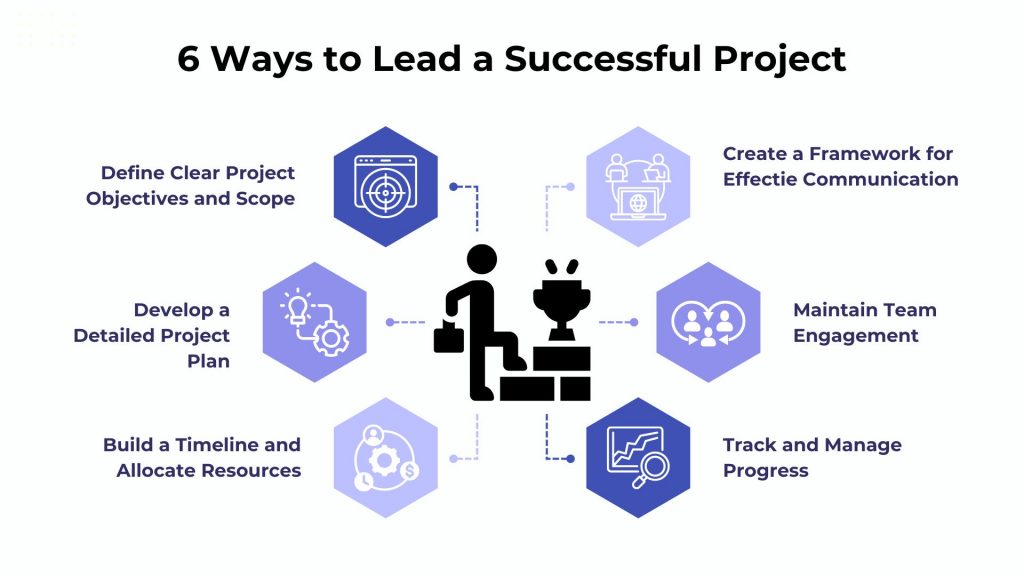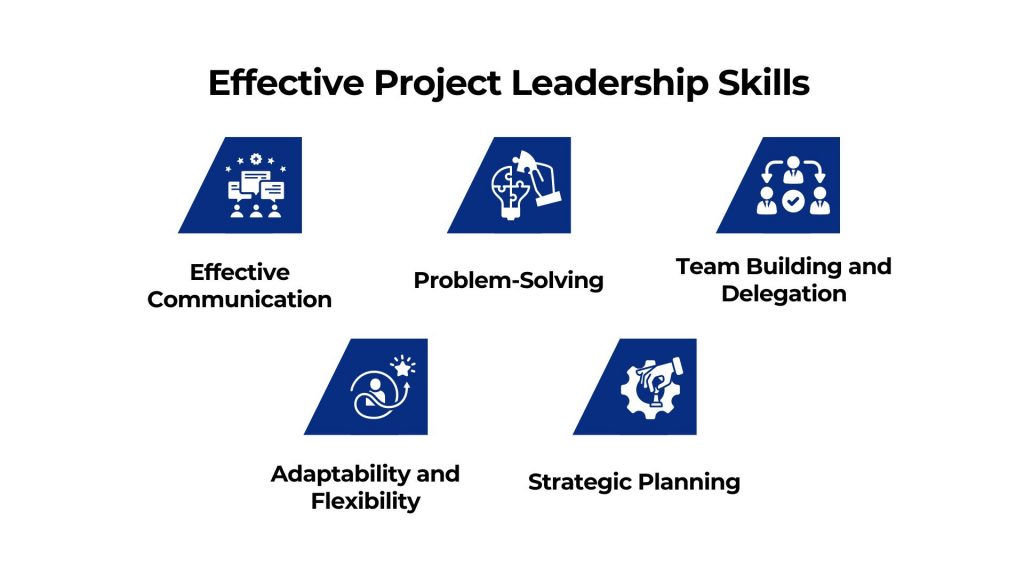
Effective project leadership has become a critical competency for organizational success within the dynamic business environment characterized by rapid change and innovation.
“Innovation distinguishes between a leader and a follower.”
-Steve Jobs, Apple co-founder
Table of Contents
- Introduction
- 5 Essential Skills of a Project Leadership
- 6 Steps to Lead Projects for Successful Project
- Conclusion
Introduction
Whether you’re managing a small team or overseeing a large-scale initiative, the principles of effective project leadership remain consistent: clear communication, strategic planning, adaptability, and a constant focus on goals.
Leading projects is not just about meeting deadlines and staying within budget; it also demands the skills to handle critical situations in a project on one hand and on the other side inspiring your project team, fostering a collaborative environment, and navigating challenges confidently.
As businesses face increasingly complex and dynamic challenges, project leaders must have the right tools and strategies to complete projects while successfully maintaining team confidence and stakeholder satisfaction.
In this blog, we will explore the essential elements of project leadership, offering practical tips and insights to help you lead a project confidently and competently.
5 Essential Skills of a Project Leadership
The measure of a project’s success often rests on its leader’s shoulders.
But fear not, aspiring project practitioners!
Effective leadership isn’t about micromanaging or wielding a heavy hand. It’s about cultivating a skilled and motivated team, navigating challenges with foresight, and guiding everyone toward a shared vision.
Here are five essential skills that successful project leaders possess. By mastering these “pillars of leadership,” you’ll be well-equipped to transform your project management style and consistently empower your team to deliver exceptional results.
-
Effective Communication
Effective communication is the baseline of successful project leadership. A project leader must be able to convey goals, expectations, and feedback to team members, stakeholders, and clients. This involves not only speaking and writing effectively but also active listening. Good communication ensures everyone is on the same page, reduces misunderstandings, and facilitates smooth progress throughout the project.
-
Problem-Solving
Problem-solving is a crucial skill for any project leader, as unexpected challenges and obstacles are inevitable in any project. A strong project leader must be able to analyze situations thoroughly, identify the root causes of issues, and develop effective solutions. This involves gathering relevant information, considering various perspectives, and making informed decisions that align with the project’s goals.
-
Team Building and Delegation
Great project leaders recognize that success hinges on a strong and motivated team. They cultivate a collaborative environment where team members feel valued and assigned to contribute their expertise. Effective delegation allows leaders to leverage individual strengths, optimize team performance, and ensure everyone feels ownership over project outcomes.
-
Adaptability and Flexibility
Adaptability and flexibility are vital skills for navigating the dynamic and often unpredictable nature of projects. A project leader must be prepared to adjust strategies in response to changing circumstances, whether due to new information, shifting priorities, or unforeseen challenges. This requires an open-minded approach, a willingness to embrace new ideas, and the ability to implement alternative plans when necessary.
-
Strategic Planning
Strategic planning is the foundation of effective project leadership. It involves developing a clear roadmap to achieve the project’s objectives. A project leader must be adept at defining goals, establishing timelines, allocating resources, and identifying potential risks. This skill requires a comprehensive understanding of the project’s scope and the ability to foresee and mitigate challenges.
6 Steps to Lead Projects for Successful Project

From defining clear objectives to reviewing and reflecting on the outcomes, each step plays a critical role in guiding a project from inception to successful delivery. By mastering these steps, you can enhance your leadership skills and drive your projects to completion, regardless of size or complexity.
-
Define Clear Project Objectives and Scope
The first step in leading a successful project is to establish clear and achievable objectives. This involves understanding the project’s goals, determining the scope of work, and setting specific, measurable, achievable, relevant, and time-bound (SMART) objectives.
By clearly defining what needs to be accomplished, you set a solid foundation for the project, ensuring that all stakeholders have a suitable understanding of the expected outcomes.
-
Develop a Detailed Project Plan
Once the goals are set, the next step is to create a comprehensive project plan. This plan should outline the tasks and activities required to achieve the project goals, along with detailed timelines and milestones. It should also include a resource allocation plan, identifying the personnel, budget, and materials needed.
A well-structured project plan is a roadmap, guiding the team through each phase of the project and helping to keep everything on track.
-
Build a Timeline and Allocate Resources
Creating a realistic timeline is essential for ensuring that your project progresses smoothly. Break down the project into manageable stages and set achievable deadlines for each. Allocate resources effectively by determining each phase’s personnel, budget, and materials. Proper resource allocation helps avoid bottlenecks and ensures the team has what it needs to meet the project’s deadlines.
-
Create a Framework for Collaboration and Communication
Establishing a solid framework for collaboration and communication is key to maintaining team cohesion and efficiency. Use project management tools and communication networks to keep everyone connected and informed.
Regular meetings, status updates, and clear feedback channels help ensure team members are aligned and address any issues promptly. A robust communication framework fosters a collaborative environment where ideas can be shared freely, and solutions can be developed collectively.
-
Maintain Team Engagement
Maintaining team engagement and motivation throughout the project lifecycle is crucial for achieving high performance. Acknowledge and celebrate both individual and team accomplishments, offer constructive feedback, and create opportunities for professional development.
Fostering an inclusive and supportive work environment can enhance confidence and inspire team members to take ownership of their tasks, ultimately contributing to the project’s success.
-
Track and Manage Progress
Effective project leadership requires continuous monitoring and control to ensure the project stays on course. This involves tracking progress against the project plan, managing risks, and making adjustments as necessary.
Use project management tools and techniques to collect data on performance, identify potential issues early, and implement corrective actions. Regular status updates and reviews with the team and stakeholders help maintain transparency and accountability.
Conclusion
Leading projects effectively is a journey, not a destination. By sharpening the skills outlined in this blog and embracing the six-step project leadership framework, you’ll be well-equipped to navigate the complexities of project management confidently.
Successful project leadership fosters a collaborative environment, expects challenges, and inspires your team to achieve their full potential. So, implement these learnings, embrace the challenges, and watch your projects transform from good to great!
Ready to lead projects like a pro? Invensis Learning’s Project Management certification courses will give you the skills to succeed. Enroll now and take your career to new heights!















